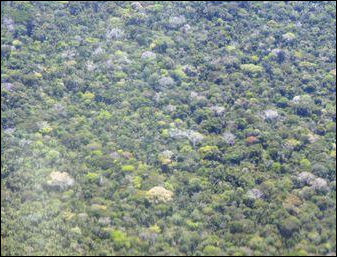RAINFOREST TREES
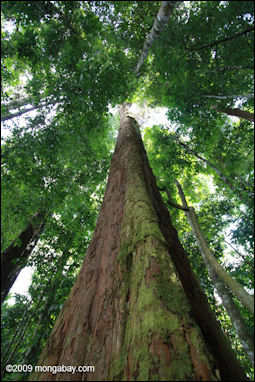
Plants need four things: sunlight, water, minerals, warmth. Leaves are the food factories for plants. In a process called photosynthesis, sunlight triggers a chemical reaction between water and minerals, absorbed by the roots, combine with chlorophyll, a remarkable chemical that gives plants their green color, in the leaves that produce starches and sugars (food for the plants) and oxygen.
Water is absorbed through tiny hairs and rootless that extend from the plant's roots. The water is supplied to the leaves trough tubes in the stems, barnacles and/or trunk. If the soil is fertile nutrients are carried to the leaves in the water. In rainforest that roots are often shallow because water is abundant. In the desert the roots often extend deep into the earth, often to all the way to the water table, many feet below the surface.
Roots are near the surface so the plants can absorb rain water before other plants do. The surface is also where most of the nutrients from decaying leaves is located. Buttress help hold the tree up. During a severe drought the water column system breaks down. In these conditions the tree is so stressed it produces a clicking sound analogous to a person gasping for air.
See Separate Articles: TROPICAL RAINFORESTS: COMPONENTS, STRUCTURE, SOILS AND WEATHER factsanddetails.com; AMAZON: THE RIVER AND FOREST AND THEIR HISTORY AND ECOLOGY factsanddetails.com; RAINFOREST LIANAS, FIGS, EPIPHYTES, FERNS, BROMELAIDS AND FUNGI factsanddetails.com; STUDYING THE RAINFOREST: METHODS, TECHNOLOGIES AND HARD WORK factsanddetails.com
Websites and Resources: Rainforest Action Network ran.org ; Rainforest Foundation rainforestfoundation.org ; World Rainforest Movement wrm.org.uy ; Wikipedia article Wikipedia ; Forest Peoples Programme forestpeoples.org ; Rainforest Alliance rainforest-alliance.org ; Nature Conservancy nature.org/rainforests ; National Geographic environment.nationalgeographic.com/environment/habitats/rainforest-profile ; Rainforest Photos rain-tree.com ; Rainforest Animals: Rainforest Animals rainforestanimals.net ; Mongabay.com mongabay.com ; Plants plants.usda.gov ;Books: “The Private Life of Plants: A Natural History of Plant Behavior” by David Attenborough (Princeton University Press, 1997); “Portraits of the Rainforest” by Adrian Forsythe. National Geographic articles “Rainforest Canopy, the High Frontier” by Edward O. Wilson, December 1991 ▸; “Tropical Rainforests: Nature's Dwindling Treasures”, by Peter T. White, January 1983 ∩
Photosynthesis
Photosynthesis takes place inside special kidney-shaped cells called chromoplasts. Inside these are tiny flattened sacs that are stacked on top of one another like pancakes,. These sacs contain pigments, the foremost of which is chlorophyl, which absorbs light energy. Light energy absorbed in the pigment and breaks down water (with two hydrogen atoms and one oxygen atom) and carbon dioxide (with one carbon atom and two oxygen atoms) with the released atoms recombining to produce carbohydrate molecules (with one carbon atom, two hydrogen atoms and one oxygen atom) and oxygen, whish is discarded.

PhotosynthesisThe carbohydrates produced by photosynthesis are the basic building blocks of all life on earth. Through various complex chemical reactions involved minerals and nutrients such as nitrogen and phosphorous, these carbohydrates can be converted into sugars, cellulose and amino acids. The food we eat, the fuel we burn and the wood we used to make our homes all are ultimately derived from photosynthesis and carbohydrates. On top of that the oxygen we breath and the oxygen that fills the atmosphere were all produced by photosynthesis. Today it helps combat global warming by absorbing carbon dioxide.
Rainforest Plant Leaves
The purpose of leaves is to absorb as much sunlight as possible from the sun. Many plants angle their leaves towards the sun and jockey with other leaves for position. Time lapse film shows them following like the sun like a head following the ball at a tennis match and move around like people in a crowd trying to catch a glimpse of a film star. Leaves can not absorb water. Rain water on a leaf in fact can disrupt photosynthesis. Most leaves have channels that direct the water off the leaves
Why leaves of different species found in same habitats form different patterns is unknown. Some of the largest leaves in the plant kingdom belong to plants that live near the ground in the rainforest. The largest undivided leaves belong to a member of the arum family of Southeast Asia and Borneo. They can reach a length of ten feet and have an area of 30 square feet.

Other species of the arum family contain a purple pigment on the underside of the leaf that catches sunlight and distributes it to food-producing parts of the leaf. Begonias that grow on the floor of Asiatic rainforests employ a similar trick. They have transparent pigment patches on the surface of their lives that serve as lenses that focus the little light it receives to food-producing parts of the plant.
The starch and sugars found in leaves supplies food for animal, mostly insects who are work around the clock munching leaves. Many plants have thorns, spines, hooks, stings, and poisons on the leaves to keep animals form eating them.
Rainforest Trees
Most tropical tree species are broad-leaf evergreens with smooth tapered leaves that allow rain to run off so branches don't break off from being waterlogged. The leaves are angled to collect the maximum amount of sunlight. Many have special joints in their stalks that allows them to twist as they track the sun as it moves across the sky. These leaves are covered with a glossy wax that prevents algae, moss or there plants from growing on them.
At ground level many trees are supported by triangular buttresses (partly above-ground roots jutting out from the trees) that help support large trees in the shallow soil and keep them from being knocked over by heavy winds. Banging on the buttresses with a log sometimes produce a sound that can be heard for miles. The roots in the thin soil are shallow and sometimes above the ground so that nutrients can be absorbed quickly. Poisonous snakes, ants, rodents and other small animals often live in the cavities around the base of the tree.
Most of the trees depend on flowers and fruit to reproduce. Since they cannot depend on wind to assist in pollination they produce flowers with bright petals that are fertilized by beetles, wasps, butterflies, other and insects. Those that count on nectar-drinking insects are nearly always red, while those that are pale and have a fetid smell are visited by bats. Fruits with seeds housed in tough coverings are consumed by creatures such as parrots, monkeys, and deer that disperse the seeds in their excrement.
Large Rainforest Trees
Growing to a great height is a great advantage for trees because it allows them out competes other plants to reach sunlight. Plants that do not grow risk being overshadowed by taller plants and not receiving enough sunlight to survive. Some of the tallest trees in rainforest are members of the pea and bean family.
Large trees can loose hundreds of gallons of water a day to transpiration on a hot day. So that their leaves don’t wilt the same amount of water that is lost has to be replaced. How is such a great volume of water moved up trunk? The trunk is made of dead tubes filled with a column of water that rises as water transpires from the leaves. Water has a high surface tension and can be drawn upwards through capillary action without breaking into small pieces.
If the trees have enough sun and water they can grow quite large. Some survive for centuries until they begin having trouble lifting sap to their crowns and branches which have been weakened by tunneling insects and the weight of algae, moss and epiphytes. Sometimes the end comes when a large branch falls off and tree loses it balances topples over. More often than not large trees come down in strong winds or a large storm.
Scientists Say There Are 73,300 Species in the World
tree buttress In early 2022, researchers unveiled the world's largest forest data base, comprising more than 44 million individual trees at more than 100,000 sites in 90 countries — and calculated that the Earth is home roughly 73,300 tree species — about 14 percent higher than previous estimates. Of that total, about 9,200 are estimated to exist based on statistical modeling but have not yet been identified by science, with a large proportion of these growing in South America.[Source: Will Dunham, Reuters, February 1, 2022]
South America, home to the enormously biodiverse Amazon rainforest and farflung Andean forests, was found to harbor 43 percent of the planet's tree species and the largest number of rare species, at about 8,200. “Trees and forests are much more than mere oxygen producers, said Roberto Cazzolla Gatti, a professor of biological diversity and conservation at the University of Bologna in Italy and lead author of the study published in the journal Proceedings of the National Academy of Sciences. "Without trees and forests, we would not have clean water, safe mountain slopes, habitat for many animals, fungi and other plants, the most biodiverse terrestrial ecosystems, sinks for our excess of carbon dioxide, depurators of our polluted air, et cetera," Gatti said.
Reuters reported: “South America was found to have about 27,000 known tree species and 4,000 yet to be identified. Eurasia has 14,000 known species and 2,000 unknown, followed by Africa (10,000 known/1,000 unknown), North America including Central America (9,000 known/2,000 unknown) and Oceania including Australia (7,000 known/2,000 unknown). "By establishing a quantitative benchmark, our study can contribute to tree and forest conservation efforts," said study co-author Peter Reich, a forest ecologist at the University of Michigan and University of Minnesota. "This information is important because tree species are going extinct due to deforestation and climate change, and understanding the value of that diversity requires us to know what is there in the first place before we lose it," Reich said. "Tree species diversity is key to maintaining healthy, productive forests, and important to the global economy and to nature."
“This study did not tally the total number of individual trees globally, but 2015 research led by one of the co-authors put that figure at about 3 trillion. The new study pinpointed global tree diversity hot spots in the tropics and subtropics in South America, Central America, Africa, Asia and Oceania. It also determined that about a third of known species can be classified as rare.
“The researchers used methods developed by statisticians and mathematicians to estimate the number of unknown species based on the abundance and presence of known species. Tropical and subtropical ecosystems in South America may nurture 40 percent of these yet-to-be-identified species, they said. "This study reminds us how little we know about our own planet and its biosphere," said study co-author Jingjing Liang, a professor of quantitative forest ecology at Purdue University in Indiana. "There is so much more we need to learn about the Earth so that we can better protect it and conserve natural resources for future generations."
Rainforest Fruiting Cycles
flowering canopy Tropical rainforest trees don't follow seasonal cues like temperate tree in flowering, fruiting and shedding the leaves. Some drop their leaves every six months. Some every 12 months and 21 days. Other do it in a piecemeal fashion, with different branches shedding at different intervals. Because many trees grow at the same rate all year, without winter and summer fluctuations, they don't have rings and thus it is difficult to determine their age.
Flowering and fruiting patterns are even more irregular. Ten-month and 14-month cycles are common. Some species only flower once a decade. In regions with pronounced wet and dry seasons the fruiting period is usually takes place right before the wet season, a time when trees are under the most stress.
In some places there sometimes seems to be no discernable pattern in the way that trees flower and fruit. Some Asian tree communities, for example, go long intervals without flowering, then suddenly burst into fruit over a large area — an unpredictable phenomena known called "masting." What stimulates them to flower on cue like this is a mystery.
Many rainforest trees reproduce with seed-bearing fruits like figs, durian, jackfruit and avocado. The ease and speed in which many of these fruits are digested by animals who can’t afford to have large stomach poses some problems for the plant. Some birds excrete the remains of fruit that they had only eaten five minutes earlier. As a result the fruit are largely deposited in the same places they would be if they just fell from the tree. Even so enough remains in the animals so that they are deposited in new places when the animals move on.
Do Trees Belong to Communities?
Peter Wohlleben, a German forester and author of the controversial but popular book “The Hidden Life of Trees: What They Feel, How They Communicate” argues that trees form communities and communicate with one another. Richard Grant wrote in Smithsonian magazine:“Since Darwin, we have generally thought of trees as striving, disconnected loners, competing for water, nutrients and sunlight, with the winners shading out the losers and sucking them dry. The timber industry in particular sees forests as wood-producing systems and battlegrounds for survival of the fittest.[Source: Richard Grant, Smithsonian magazine, March 2018]
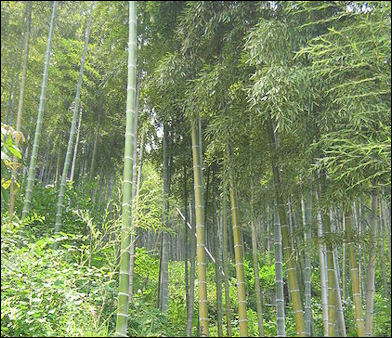
bamboo forest“There is now a substantial body of scientific evidence that refutes that idea. It shows instead that trees of the same species are communal, and will often form alliances with trees of other species. Forest trees have evolved to live in cooperative, interdependent relationships, maintained by communication and a collective intelligence similar to an insect colony. These soaring columns of living wood draw the eye upward to their outspreading crowns, but the real action is taking place underground, just a few inches below our feet. “Some are calling it the ‘wood-wide web,’” says Wohlleben in German-accented English. “All the trees here, and in every forest that is not too damaged, are connected to each other through underground fungal networks. Trees share water and nutrients through the networks, and also use them to communicate. They send distress signals about drought and disease, for example, or insect attacks, and other trees alter their behavior when they receive these messages.”
“Scientists call these mycorrhizal networks. The fine, hairlike root tips of trees join together with microscopic fungal filaments to form the basic links of the network, which appears to operate as a symbiotic relationship between trees and fungi, or perhaps an economic exchange. As a kind of fee for services, the fungi consume about 30 percent of the sugar that trees photosynthesize from sunlight. The sugar is what fuels the fungi, as they scavenge the soil for nitrogen, phosphorus and other mineral nutrients, which are then absorbed and consumed by the trees.
“For young saplings in a deeply shaded part of the forest, the network is literally a lifeline. Lacking the sunlight to photosynthesize, they survive because big trees, including their parents, pump sugar into their roots through the network. Wohlleben likes to say that mother trees “suckle their young,’’ which both stretches a metaphor and gets the point across vividly.
“Once, he came across a gigantic beech stump in this forest, four or five feet across. The tree was felled 400 or 500 years ago, but scraping away the surface with his penknife, Wohlleben found something astonishing: the stump was still green with chlorophyll. There was only one explanation. The surrounding beeches were keeping it alive, by pumping sugar to it through the network. “When beeches do this, they remind me of elephants,” he says. “They are reluctant to abandon their dead, especially when it’s a big, old, revered matriarch.”
Tree Communication?
Richard Grant wrote in Smithsonian magazine: “To communicate through the network, trees send chemical, hormonal and slow-pulsing electrical signals, which scientists are just beginning to decipher. Edward Farmer at the University of Lausanne in Switzerland has been studying the electrical pulses, and he has identified a voltage-based signaling system that appears strikingly similar to animal nervous systems (although he does not suggest that plants have neurons or brains). Alarm and distress appear to be the main topics of tree conversation, although Wohlleben wonders if that’s all they talk about. “What do trees say when there is no danger and they feel content? This I would love to know.” Monica Gagliano at the University of Western Australia has gathered evidence that some plants may also emit and detect sounds, and in particular, a crackling noise in the roots at a frequency of 220 hertz, inaudible to humans. [Source: Richard Grant, Smithsonian magazine, March 2018]
“Trees also communicate through the air, using pheromones and other scent signals. Wohlleben’s favorite example occurs on the hot, dusty savannas of sub-Saharan Africa, where the wide-crowned umbrella thorn acacia is the emblematic tree. When a giraffe starts chewing acacia leaves, the tree notices the injury and emits a distress signal in the form of ethylene gas. Upon detecting this gas, neighboring acacias start pumping tannins into their leaves. In large enough quantities these compounds can sicken or even kill large herbivores.
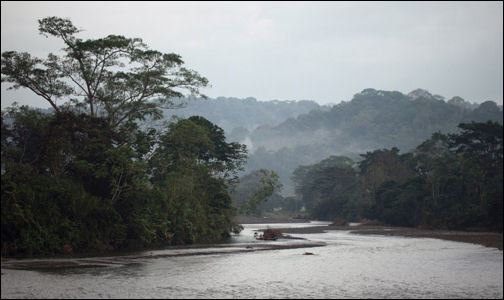
Columbia
“Giraffes are aware of this, however, having evolved with acacias, and this is why they browse into the wind, so the warning gas doesn’t reach the trees ahead of them. If there’s no wind, a giraffe will typically walk 100 yards — farther than ethylene gas can travel in still air — before feeding on the next acacia. Giraffes, you might say, know that the trees are talking to one another.
“Trees can detect scents through their leaves, which, for Wohlleben, qualifies as a sense of smell. They also have a sense of taste. When elms and pines come under attack by leaf-eating caterpillars, for example, they detect the caterpillar saliva, and release pheromones that attract parasitic wasps. The wasps lay their eggs inside the caterpillars, and the wasp larvae eat the caterpillars from the inside out. “Very unpleasant for the caterpillars,” says Wohlleben. “Very clever of the trees.”
“A recent study from Leipzig University and the German Centre for Integrative Biodiversity Research shows that trees know the taste of deer saliva. “When a deer is biting a branch, the tree brings defending chemicals to make the leaves taste bad,” he says. “When a human breaks the branch with his hands, the tree knows the difference, and brings in substances to heal the wound.”
Tree Families?
Young beech trees, in their own individual ways, are tackling the fundamental challenge of their existence. Like any tree, they crave sunlight, but down here below the canopy, only 3 percent of the light in the forest is available. One tree is the “class clown.” Its trunk contorts itself into bends and curves, “making nonsense” to try to reach more light, instead of growing straight and true and patient like its more sensible classmates. “It doesn’t matter that his mother is feeding him, this clown will die,” says Wohlleben.
“Another tree is growing two absurdly long lateral branches to reach some light coming through a small gap in the canopy. Wohlleben dismisses this as “foolish and desperate,” certain to lead to future imbalance and fatal collapse. He makes these blunders sound like conscious, sentient decisions, when they’re really variations in the way that natural selection has arranged the tree’s unthinking hormonal command system
“Mother trees are the biggest, oldest trees in the forest with the most fungal connections. They’re not necessarily female, but Simard sees them in a nurturing, supportive, maternal role. With their deep roots, they draw up water and make it available to shallow-rooted seedlings. They help neighboring trees by sending them nutrients, and when the neighbors are struggling, mother trees detect their distress signals and increase the flow of nutrients accordingly.
At the University of British Columbia in Vancouver, Suzanne Simard and her grad students are making astonishing new discoveries about the sensitivity and interconnectedness of trees in the Pacific temperate rainforests of western North America. Peter Wohlleben has referred extensively to her research in his book. Using seedlings, Amanda Asay one of Sinard’s grad students, and fellow researchers have shown that related pairs of trees recognize the root tips of their kin, among the root tips of unrelated seedlings, and seem to favor them with carbon sent through the mycorrhizal networks. “We don’t know how they do it,” says Simard. “Maybe by scent, but where are the scent receptors in tree roots? We have no idea.”
“Not all scientists are on board with the new claims being made about trees. Where Simard sees collaboration and sharing, her critics see selfish, random and opportunistic exchanges. Stephen Woodward, a botanist from the University of Aberdeen in Scotland, warns against the idea that trees under insect attack are communicating with one another, at least as we understand it in human terms. “They’re not firing those signals to anything,” Woodward says. “They’re emitting distress chemicals. Other trees are picking it up. There’s no intention to warn.”
“Lincoln Taiz, a retired professor of plant biology at the University of California, Santa Cruz and the co-editor of the textbook Plant Physiology and Development, finds Simard’s research “fascinating,” and “outstanding,” but sees no evidence that the interactions between trees are “intentionally or purposefully carried out.” Nor would that be necessary. “Each individual root and each fungal filament is genetically programmed by natural selection to do its job automatically,” he writes by email, “so no overall consciousness or purposefulness is required.” Simard, it should be noted, has never claimed that trees possess consciousness or intention, although the way she writes and talks about them makes it sound that way.
Different Kinds of Rainforest Trees

palm leaf If all rainforest trees look alike to you, you are not the only one that feels this way. Botanists often have difficulty telling trees and plants apart. Variations between plants are often subtle and only apparent for a short period of time when a species bears flowers or fruit, which is not coincidently is when scientists prefer to collect specimens and make identifications.
Three quarters of all tropical rainforest tree species are considered rare. Generally only a few trees of a specific species but many different species can be found in a 100 acre area.
Dipterocarp rainforests of Borneo and Southeast Asia are taller and have fewer lianas connecting trees than the more broken canopy of Amazonian forests.
Giant kapok, or silk cotton trees, are fixtures of Latin American forest. Similar tree are found in Africa and Southeast Asia. Kapok seeds have cottony tufts that allow them to be carried by the wind. The seeds in the similar trees in Africa and Southeast Asia have wings that causes them to spiral downwards and sometimes be carried away by winds.
Palms
Palms grow primarily in tropical areas but are also found in the highlands of the Himalayas and the Andes, in mangrove swamps and in the desert. Members of a diverse plant group that also includes grasses and orchids, they range in height from six inches to 200 feet. Some palms are trees. Some are bushes. Rattan palms, which grow as a vine, can reach lengths of 600 feet or more.
Palm trees do not branch. They generate all their growth from a huge bud at the apex of the tree, which is called the palm heart. It produces leaf after leaf as the plant grows. The palm heart is often very tasty and animals like to eat it. If something happens to it the plant can die. Many palms have sharp spines for protection.
Palm trunk have a pith center but no bark or growth rings. Leaves called fonds fan out from a crown at the top. Some leaves are 30 to 45 feet long and 4 to 8 feet wide. African raffia palms have the world’s largest leaves, reaching 75 feet in length.
Palms bear flowers and fruit. The fruits have hard kernels containing tiny germs. Some kernels, such as dates, are surrounded by a fleshy pulp. The world’s largest seed, a double coconut from the Seychelles, comes from a palm. Most palms begin flowering when they five or six and mature when they are 10 to 15 years old. Some palms live 150 years or more.
There are several thousand species of palms. Valuable kinds of palm include coconut palms, date palms, sago palms, betel nut palms. Some palms produces a sweet sap that is made into candy, sugar and wine. The nuts of the tagua palm yields vegetable ivory. Carnauba palm leaves produce wax.
Palm tree trunks are used in the construction of houses, boats and bridges that cross canals. They are used to make grids and fences. Elastic fibers that the cover the trunks are used to make camel and horse saddles. Parts of the leafstalk are used as trowels by mason and as beaters by washerwomen. Mats, plates and baskets are made with stalks. Among the other things made with palms are dye, paper, surfboards, and wax.
See Coconuts, Dates, Palm Oil, Palm Hearts, Food
Bamboo
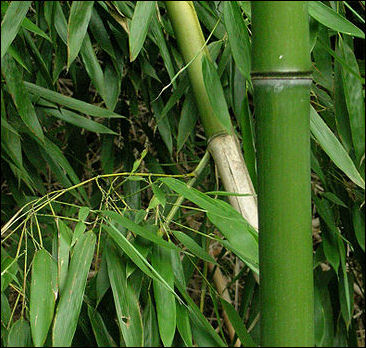
Bamboo is a kind of grass that can grow to size of a tree. The stems are, hollow, polished and jointed and sometimes reach three feet across. Some flower and seed every year; other only do so one every 60 years or so. Some species of bamboo die off en masse after a single flowering. One such die off killed hundred of giant pandas in China in the 1980s. Depending on the species, the die off can occur everywhere from one every dozen year or so to once every century.
In the short term bamboo reproduce by sending up new stems rather than by producing seeds. A single root may produce as many as 100 stems. These stems breaks the soil with it nodes already formed and can grow as much as a meter in a single day. Bamboo doesn't have rings like a tree. The hollow nodes are already developed when they emerges in the spring and grows like an uncoiling party favor.
There are more than 500 species of bamboo. Some species of bamboo — such as Bambusa Arundinacea of India and Phyllostacys and China — reach heights of 100 feet. Bamboo is both flood- and drought resistant. Hikers who run out of water in the Malaysian rainforest can get about a canteen's worth by boring a hole right above the joint of large stalks of bamboo.
Bamboo is used for all kinds of things: homes, musical instruments, food, scaffolding, Bamboo has been made into a fabric used to make denim trousers. Surprisingly soft, it is naturally antimicrobial and odor resistant.
Bamboo Ecosystems
Some plants have entire ecosystems with a variety of animals living in them. At Peru's Manu Biosphere Reserve, scientists have discovered a species of thick “guadua” bamboo that supports large populations of ants, beetles and roaches and even snakes and frogs, that actually live within the bamboo's stalks. [Source: Adele Conover, Smithsonian magazine]
The bamboo is dived into sections, called nodes, which collect water that is naturally pumped through the plant. The females of a particular kind of katydid digs holes in the bamboo with long knifelike ovipositors so that they can squeeze their abdomen into the bamboo to lay eggs. Guanda bamboo grow at amazing speeds’sometimes a meter a day — and as it grows the holes made by the katydids expand and elongate creating entry points for rainforest creatures.
Mosquitos, crane flies and other aquatic insects enter the stalks and lay eggs in the water. Their larvae feeds off rotting bamboo sediments and katydid eggs. Birds like the rufous-headed woodpecker drill rectangular holes into the stalks to extract insects, and monkeys "unzip" the elongated katydid cavities to gather food. Eventually the openings are large enough for poison-arrow frogs, finger-size rhinoceros beetles and lizards to enter and feed on the insects and larvae, and lay their eggs. Last but least are tree snakes which climb into the holes to feed on frogs and lizards.
Image Source: Mongabay mongabay.com ; Wikimedia Commons
Text Sources: “The Private Life of Plants: A Natural History of Plant Behavior” by David Attenborough (Princeton University Press, 1997); National Geographic articles. Also the New York Times, Washington Post, Los Angeles Times, Smithsonian magazine, Natural History magazine, Discover magazine, Times of London, The New Yorker, Time, Newsweek, Reuters, AP, AFP, Lonely Planet Guides, Compton’s Encyclopedia and various books and other publications.
Last updated April 2022


